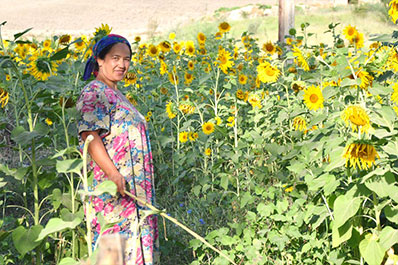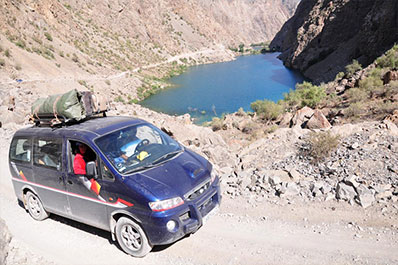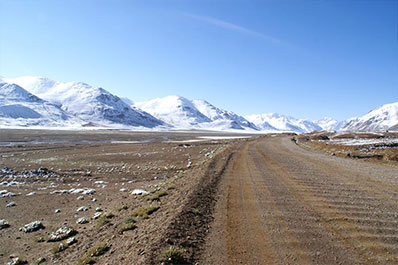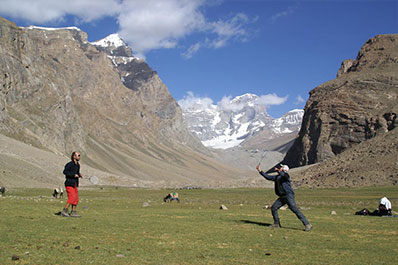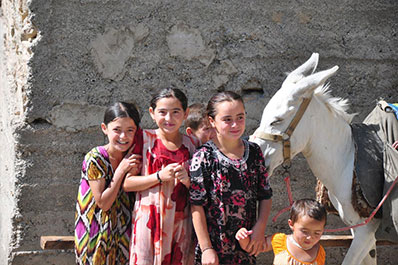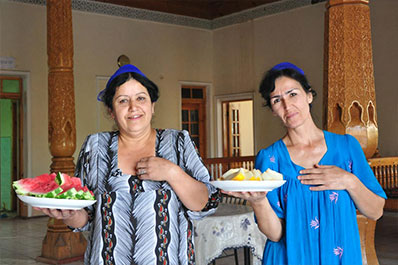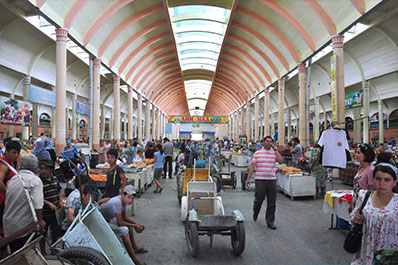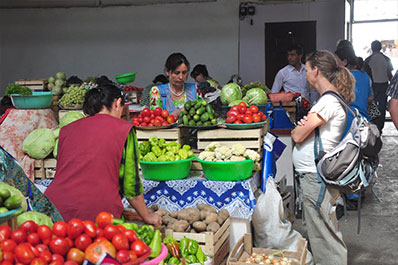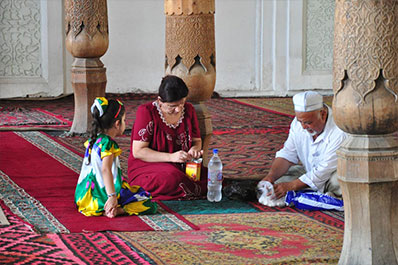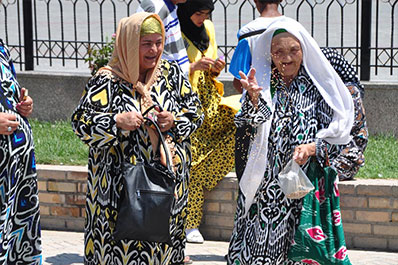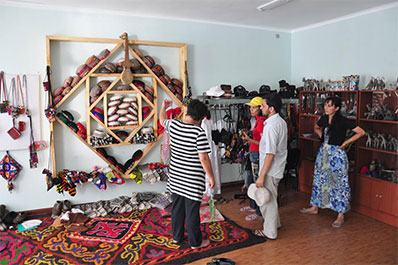Tajikistan Travel Guide
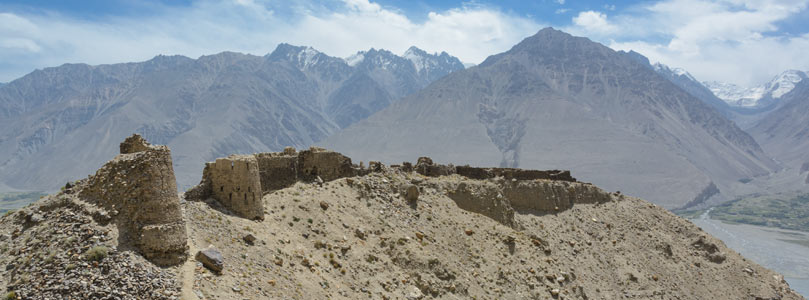
Tajikistan is the perfect travel destination for anyone in search of a unique, adventurous, unforgettable holiday. Home to the majestic Pamir Highway and some of the most exquisite mountains in the world, backpackers, hikers, cyclists and nature enthusiasts alike will be drawn to its remote and well-preserved environ. A meshing of past and present, a venture to this lesser-known land leaves many with the impression that they have not just traveled the globe, but stepped back in time. A tapestry of color and tradition, time spent in Tajikistan will expand your horizons and enrich your worldview.
Though the country is still developing and continues to improve its services to tourists, opportunities abound for every type of travel: whether community-based tourism or cross-country trekking, cultural immersion or historical awareness, independent tourism or guided travel to Tajikistan, as long as you’re ready to experience the unknown and step out of your comfort zone, you won’t be disappointed in Tajikistan!
General information about Tajikistan
Tajikistan Capital: Dushanbe
Population: 9.32 million (2019)
Languages: Tajik, Uzbek, Russian
Religion: Islam 96% (Sunni 90.4%, Ismaili Shi'a 5.6%), Russian Orthodox (2.6%)
Electricity: 220V AC, 50 Hz; Round two-pin continental plugs are standard
Time zone: GMT+5
International dialing code: +992
Monetary unit: Tajikistan Somoni
What’s the climate in Tajikistan, and when is the best time to visit?
Due to the mountainous terrain that naturally divides the country, Tajikistan is a mix of continental, polar and subtropical climates. The capital, Dushanbe, generally sees hot summers and cold, wet winters.
While much of Central Asia is at its prime in spring and autumn, Tajikistan comes to life in the summer months. From June to September, mountain hikes, camping, cycling, swimming and cross-country travel are both possible and enjoyable. Most of the country escapes the scorching heat that suppresses neighboring Uzbekistan and South Kazakhstan while still enjoying endless days of summer sunshine.
For winter sports enthusiasts, December to March will be a paradise of snowy mountains, trekking and skiing opportunities in abundance. For other travelers, the winter months can bring travel delays and closed mountain passes, although seeing this gorgeous mountain country blanketed in white can make the inconvenience worth it for some tourists.
Spring and autumn see unpredictable weather, significant rainfall and occasional landslides in the mountainous areas, yet the country will be much livelier than in the wintertime, with many outdoor activities still available. Traveling to Tajikistan at this time of year will help you to avoid both the cold, snowy winter conditions and the influx of international travelers throughout the summer.
What airlines fly into Tajikistan?
Flights to Tajikistan tend to arrive and depart at odd hours of the night and early morning and are often more expensive than flights to other Central Asian nations. However, it’s possible to fly into the capital, Dushanbe, from the Central Asian cities of Bishkek, Almaty, Tashkent and Urumqi and from more international hubs such as Dubai, Frankfurt, Istanbul, Moscow, Saint-Petersburg and Teheran.
Currently the following airlines provide flights in and out of Dushanbe, Tajikistan:
Air Astana
AtlasGlobal
China Southern Airlines
Emirates
Kam Air
S7 Airlines
SCAT Airlines
Somon Air
Turkish Airlines
Ural Airlines
UTair Aviation
Uzbekistan Airways
You can visit the airline websites or contact OrexCa or another travel agency to receive up-to-date flight info and book flights in advance.
Can you travel to Tajikistan by land?
Tajikistan can be entered through land borders with each of its neighbors – Uzbekistan, Kyrgyzstan, Afghanistan and China. The checkpoints are subject to close unpredictably due to inclement weather, security issues or holidays, so it’s advised to double-check the situation before heading for the border.
The border crossings shared with Uzbekistan operate 24/7, while the crossings with Kyrgyzstan, Afghanistan and China typically open from 8 or 9am until the evening, with an hourlong break for lunch at 1pm. Border crossings in these latter countries are in more remote locations, and it’s recommended to arrange for onward transportation in advance.
Do I need a visa to visit Tajikistan?
There are four variations of visa requirements for Tajikistan, depending on your passport country:
- Citizens of select Asian and Eastern European countries, including many former USSR nations, may stay in Tajikistan without a visa for a period of 10 days to unlimited stay (length of stay is dependent on your passport country).
- Citizens of over 60 nations may obtain a Tajikistan tourist visa upon arrival for $35, pending prior approval and electronic confirmation. Visas upon arrival are only issued at the Dushanbe and Khujand airports.
- Most nationalities may obtain a 45-day Tajikistan e-visa, which can be obtained online at www.evisas.tj. The cost is $50 and includes a permit for the Gorno-Badakhsan Autonomous Region (GBAO), which previously had to be obtained separately.
- All individuals not eligible for one of the options listed above can obtain a tourist visa at a Tajikistan consulate or embassy for a minimum of $25.
For further information on Tajikistan tourist visas and details specific to your passport country, please refer to our Tajikistan Visa Requirements page.
What should I expect when entering and exiting Tajikistan?
Upon arrival to Tajikistan, whether by land or air, you’ll be required to fill out two customs declaration forms, one of which will be returned to you. Make sure to declare ‘Tourism’ as your reason of entry (assuming, of course, that you’re entering on a tourist visa) and check to ensure that the card has been stamped. Keep this card in a safe place, as you must present it at customs again when exiting the country.
Certain items are forbidden from being brought into Tajikistan, including medications that contain codeine and Tajik currency (somoni).
Guests are prohibited from taking food, antiques and items of cultural significance out of the country. If taking local handicrafts over 50 years old or any jewelry, you’ll need to get a certificate at purchase, which you may be required to show at the customs desk. You may not carry out more than $2000 in cash, and any amount over $500 must be declared.
Upon exiting Tajikistan, you’ll be required to show the following:
- Passport
- Visa that has not yet expired (unless you’re eligible for visa-free entry)
- Customs declaration filled out upon entry
You’ll be required to fill out a second customs declaration card and turn it in along with the original one.
Do I need to register in Tajikistan? How do I register?
Most travelers to Tajikistan will not need to worry about registration, as it is no longer required on the 45-day e-tourist visa.
Visitors on any other type of visa, or anyone traveling without a visa, needs to receive a registration stamp from their hotel or guesthouse before visiting the Immigration Police (OVIR) for complete registration. You can only register at the OVIR in Dushanbe or Khorog and must do so within your first 3 days in country. (I couldn’t corroborate the number of days).
For further information on registration in Tajikistan, please refer to our Tajikistan Visa Requirements page.
Is Tajikistan safe for tourists?
Although the country has seen sporadic violence, these incidents are exceptions to the generally safe environment for tourists in Tajikistan.
Safety for tourists is a priority of the government, and the country maintains a low rate of violent crime, a welcoming attitude towards tourists and a genuine spirit of helpfulness and hospitality.
To lessen security concerns, it’s advised that tourists avoid travel in the border regions, where occasional skirmishes flare up. It’s also a good idea to double-check weather and road conditions before traveling in the mountains, particularly the Gorno-Badakhstan Autonomous Region, which is prone to closed or damaged roads, mudslides and avalanches. While pickpocketing is uncommon, nevertheless keep a close eye on your valuables in crowded areas and locations frequented by tourists.
The greatest threat that you’re likely to face in Tajikistan is digestive issues from improperly cooked food or unfiltered water. By taking simple precautions – only drink bottled water, thoroughly wash and peel all produce before consumption and bring necessary medications with you as a preemptive measure – this discomfort can be avoided or at the very least, minimized.
Most travelers to Tajikistan are pleasantly surprised at the warmth of the people and the safe environment in which they find themselves.
Is Tajikistan safe to travel alone?
Solo travelers to Tajikistan have had very positive experiences, feeling safe and well-cared for by the vast majority of the local people that they meet. The Tajiks’ hospitable nature and genuine concern for the well-being of guests in their country can be sensed, and according to Tajikistan etiquette many will go out of their way to assist travelers, particularly women and those who are alone.
The primary issues faced by lone travelers in Tajikistan have been the challenges of language barriers and the expense of trying to negotiate their way alone through the country’s somewhat chaotic transportation system. Women traveling alone can minimize unwanted attention by avoiding unnecessary conversation with Tajik men.
Solo travelers who want to maintain their independence while still having some camaraderie and help with logistics could benefit from joining a Tajikistan city tour, 1 or 2-day short tours or an extension tour to Tajikistan from Uzbekistan. Women traveling alone can also join a Female Friendly Small Group Tour, created specifically with single women travelers in mind.
All in all, it can be a very positive experience.
What language do they speak in Tajikistan?
The national language of Tajikistan is Tajik, an Indo-European language that’s closely related to Farsi (Persian). The Tajikistan government has made substantial efforts to promote the use of Tajik in all spheres of public and private life. Tajik is gaining ground among the once-Russified upper classes and continues its role as the vernacular of the majority of the country's population. There has been a rise in the number of Tajik publications. Increasing contact with media from Iran and Afghanistan, after decades of isolation under the Soviets, is also having an effect on the development of the language.
Russian is still used as a common language for official and everyday communication, but as the native Russian population has gradually dwindled over the years and pride in Tajik culture has grown, Russian is used less and less, even in the capital. Unless you’re in a very remote village, however, most people will speak at least basic Russian and it’s still an effective form of communication throughout the country.
Other minority languages in Tajikistan include Uzbek, spoken by nearly a million native Uzbeks and understood by many Tajiks. The peoples of the Gorno-Badakhshan region and the Yagnob Valley, speak Yaghnobi, Shugni and other lesser-known languages as their native tongue.
English is note widely spoken in Tajikistan, particularly outside the capital.
What food do they eat in Tajikistan?
Traditional Tajik cuisine has much in common with Persian, Afghan, and Uzbek cuisines.
Traditional Tajik meals start with a spread of dried fruit, nuts, halva, and other sweets arranged on the table in small dishes, and then progresses to soup before finishing with plov. Meals are usually served on a dastarkhan, a tablecloth spread on the ground, with large cushions placed around it for sitting.
Plov, also known as osh, is the national dish of Tajikistan. It’s a rice dish made with shredded yellow carrots and pieces of meat, all fried together in vegetable oil in a large pot over an open flame. Other common ingredients include whole garlic bulbs, onions, chickpeas, raisins, quinces, apricots, and other fruits. The dish is eaten communally from a single large plate placed at the center of the table; traditionally, plov is eaten with the right hand, and this practice is still often observed in rural areas.
Another traditional dish is qurutob: dried balls of salty cheese are dissolved in water and the liquid is poured over strips of thin flaky flatbread. Before serving, the dish is topped with fried onions and other vegetables. No meat is added.
Many Tajik foods are eaten in other Central Asian countries, too. One of these is shashlik (meat kebabs), which are sold on nearly every street corner in Central Asia.
Traditional Tajik soups include meat and vegetable soups (such as shurbo and piti) and meat soups with noodles (such as laghman and ugro).
Other regional dishes include manti (steamed meat dumplings), samsa (pastry with meat or potato filling), and belyash, deep-fried cakes made of yeast dough and filled with minced meat.
Dairy dishes, usually eaten with flatbread, include chaka (sour milk), thick yogurt, and kaymak (clotted cream). Qurt balls may be served as a snack or an accompaniment to cold beverages. Kefir, a drinkable yogurt, is often served with breakfast.
Meals are always served with naan, a flatbread found throughout Central Asia. If naan is left on the ground, people will put it up on a high ledge for beggars or birds. Legend holds that one is not supposed to place naan upside down, as this will bring bad luck. Similarly, nothing should be set atop the naan, unless it is another loaf of bread.
Green tea accompanies every meal and is frequently offered between meals as a gesture of hospitality to guests and visitors. It is served hot and is drunk with or without sugar from small saucer-like cups without handles. Because of the universal popularity of tea-drinking, the chaikhana (teahouse) is the most common gathering place in Tajikistan for men, replacing the Western-style coffee house.
In the summer, Tajikistan overflows with fruit: its grapes and melons were famous throughout the former Soviet Union. The bazaars are brimming with fresh pomegranates, apricots, plums, peaches, apples, pears, figs, persimmons, quinces and berries.
Is alcohol legal in Tajikistan?
Alcohol is legal in Tajikistan, although its consumption is banned in some public places, such as parks and neighborhoods. Those who adhere to Islamic practice more stringently often abstain from drinking alcohol altogether, and may frown upon those who do.
However, alcoholic drinks, particularly beer and vodka, can be purchased in pubs and at many shops and restaurants. It’s also widely consumed at most weddings and celebratory gatherings (with the exception of religious events).
Is Tajikistan an Islamic country, and how should I dress while there?
Tajikistan is officially a secular country, although the majority of the population are Muslim, and the country is considered the most conservative in Central Asia. Strict adherence to Islam, including the wearing of the hijab, growing a beard and regular mosque attendance is discouraged, and many mosques have been shut down in recent years.
Local attire for men usually consists of a collared shirt and slacks, and a long dress for women with slacks worn underneath. While there is no enforced dress code in Tajikistan, travelers desiring to show sensitivity toward the local culture may want to refrain from wearing short and sleeveless shirts (men and women) and tight-fitting clothing in rural areas. The dress code in the city is considerably more relaxed, with a mix of traditional and Western attire worn by the local population.
If coming during the summer months, cool, loose-fitting clothing, sandals and a hat are recommended, while warmer gear will be necessary for the mountain passes even in summer. If traveling in spring or autumn, the obvious essentials of a rain jacket, umbrella and sweaters are a good idea, too. For winter, warm underlayers and snow boots are recommended. Women may want to have a scarf with them to cover the head and shoulders during trips to religious sites.
Can I use credit cards in Tajikistan?
The general rules of cash and credit card use in Central Asia apply in Tajikistan – it’s primarily a cash economy, and your debit or credit card will be of little value in paying anywhere outside of large hotels and expensive restaurants in Dushanbe. The capital, larger cities and many towns all have ATMS in which you can withdraw cash with a foreign credit card, although they are subject to be out of order or out of cash on a frequent basis.
A general rule of thumb is to bring with you most or all of the cash you expect to spend in country, and when you see a working ATM that accepts Visa or MasterCard, seize the opportunity.
Dollars and often Euro or ruble can be exchanged at select banks, high-end hotels and money exchange offices. Exchanging on the black market is illegal but possible. Be sure to check the rates, get a receipt and double-check that you’ve been given the correct exchange.
Does Tajikistan have internet?
Tajikistan has widespread internet, although expect it to be slower than you’re accustomed to. As could be expected, it generally works much better in the cities than in rural areas, and more remote villages and regions may have no internet access at all.
Internet cafes still exist in the cities, and Wi-Fi is available in most hotels, guest houses and select cafes and coffee shops in Dushanbe, Khorog and Panjikent. Access to many social media and news sites may be spotty or unavailable while in country.
Another option is to obtain a SIM card, which are usually very cheap and widely available from several local providers. You will need to show your passport in order to buy a Tajik SIM card.
Is Tajikistan expensive?
Tajikistan is the poorest country in Central Asia, and overall the cheapest one in which to travel. Food and public transport are very cheap, and budget accommodation can be found in most areas.
That being said, there are certain aspects of travel in Tajikistan that can quickly eat into your wallet. These are some of the most expensive activities in Tajikistan, and our suggestions for how to cut back on costs:
International flights – Flying internationally in and out of Tajikistan can cost hundreds and thousands of dollars. Consider coming in autumn or winter, when tickets are usually cheaper, or flying into neighboring Uzbekistan or Kyrgyzstan and crossing into Tajikistan by land.
Travel in the Pamirs – Hiring a private car or 4WD through the Gorno-Badakhhsan region will cost at least $1000 per week. You can cut costs by pairing up with other travelers to split the price 3 or 4 ways, or by taking a local shared taxi when available (they leave once the entire car has filled up). Generally, the more you’re on the road, the higher your expenditures are going to be, so consider staying in one or two remote areas rather than driving to a new location each day.
Cross-country travel – Since the infrastructure of Tajikistan is still being developed for tourists, there is often no convenient way to travel cross-country or to remote sites. If you’re able to plan for an extended stay in country and travel leisurely between stops, public bushes and marshrutkas (vans) can be a good option. If your time is limited or travel on public buses in a foreign country is not your preference, joining a small group budget tour might be a good fit.
Special Activities – Planned activities such as guided hikes, horseback riding and cultural immersion experiences can quickly add up. If you’re wanting economical options without sacrificing adventure, consider independent travel, overnight homestays and simply engaging with the Tajik people around you, many of whom will be eager to interact with you and offer you unique glimpses into their culture. If you’re willing to brave the cold, consider traveling in the off season (generally November-March), when activities may be provided at a discount.
What accommodations are available in Tajikistan?
Tajikistan has a surprisingly good selection of accommodation in all of its major cities, yet another sign that the country is taking steps to create a tourist-friendly environment. Upscale, midrange and budget hotels and hostels are all available, although the midrange and budget options are known for their Soviet-style service and an often basic standard of cleanliness. For affordable lodging, however, guest houses, bed and breakfasts, AirBnB and even Couchsurfing can be found in nearly every city. AirBnB is a great choice if you’re wanting more privacy, while the other options afford you the opportunity to experience the culture up-close and personal as you rent a room in a family-run business or private home.
Leaving the cities, the choice of accommodation is much more limited and homestays, particularly through Community-Based Tourism (CBT), are the primary, if not only, option. These will usually be offered at a fixed price that includes 1-3 meals per day. Bear in mind that if a host family or individual offers additional meals or services, monetary compensation is fair and tipping in Tajikistan is appropriate in such situations. If you’re planning to stay with a local family, consider bringing along a gift from your home country as a token of appreciation.
When in rural regions, camping can be another great alternative, although if you’re not bringing your own camping gear, the cost to rent all of the necessary equipment can quickly add up to more than the cost of a homestay or budget hotel. Even in summer temperatures can be quite low at higher altitudes, so if you’re planning to camp out, remember to bring appropriate attire.
What’s the best way to travel around Tajikistan?
Travel within Tajikistan is cited by many visitors as one of the biggest challenges of the trip. There are several options to consider:
- If traveling in a tour group, the transportation will be pre-arranged as part of the Tajikistan Tourism Package and you will not need to negotiate or book any of the travels yourself
- In-country aviation services are limited to flights from Dushanbe to Khujand or Khorog. These flights need to be booked through a travel agency or from the Tajik Air offices in country.
- Public transportation, including buses, marshrutkas and shared taxis, are the cheapest option and a great way to experience real life in Tajikistan. This option is not very convenient for those who are short on time.
- Train travel in Tajikistan is limited due to its mountainous terrain. The railway system currently connects western Tajikistan with Uzbekistan, but for in-country travel, this is only an option from Dushanbe to Kulob or Qurgonteppa.
- Renting a private vehicle will give you greater autonomy, but is also more expensive and only recommended for those with experience driving under poor road conditions and on mountainous terrain.
- Hiring a private driver or taxi is costly but also more convenient, and an option that many tourists choose, particularly for travel to the Pamirs. Private drivers/guides can be hired through a reputable travel agency.
What is Tajikistan famous for, and what kind of souvenirs can I bring home?
The fact that Tajikistan sits atop the Roof of the World, the Pamirs, and boasts of the Pamir Highway, the second-highest thoroughfare in the world, is reason enough to warrant a trip here. Yet the country also stands apart as a mini Persian empire amidst Turkic-speaking Central Asia, known in the region for having retained many traditional customs, style of dress and pace of life that are slowly eroding in other parts of the world.
Tajikistan has a wide selection of authentic, handmade souvenirs to choose from. Gulduzi are locally embroidered items of clothing, carpets, tablecloths, bedding and home decorations, unique in their blend of colors, depictions and intricate style. Other fabrics, including silk decorations, local dresses and suzanis (beautifully hand-stitched wall hangings) are also easy to pack into your suitcase, and they make great gift options. Or consider the Tajik variant of the Central Asian head covering – men’s skullcaps and women’s festive headscarves, shawls and handkerchiefs.
Leather items, particularly purses, slippers and jewelry, are popular in country, as is gold jewelry. Ceramic pottery, formed with a technique passed down in the land for centuries, include tea sets, figurines, plates, pitchers, fruit bowls and assorted dishes. Children and adults alike will appreciate the handmade local dolls, soft, colorful and dressed to reflect traditional Tajik style. Carpets, while not as popular in Tajikistan as in Turkmenistan and Uzbekistan, are nonetheless intricately woven and a great reflection of local artisanship.
If you’ve found this Tajikistan Travel Guide helpful, check out our travel guides for other Central Asian and Caucasus nations to learn more about the region!

